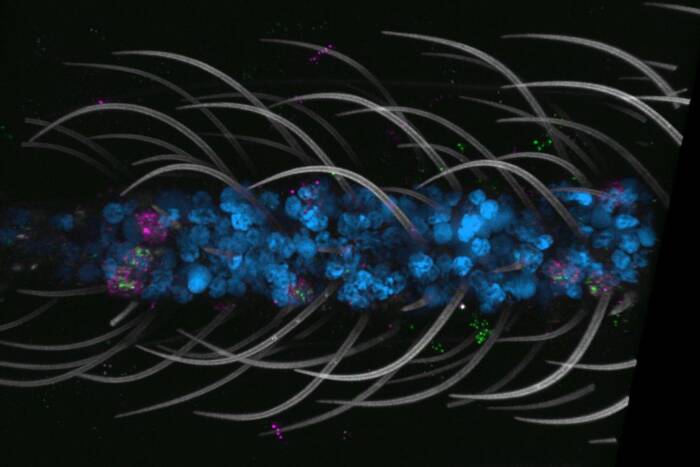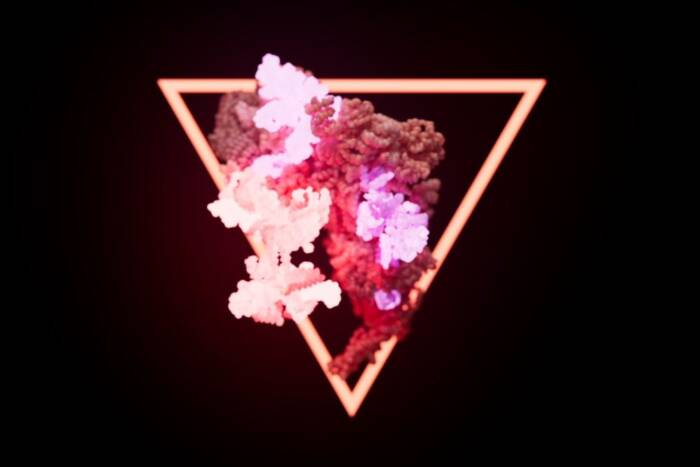Developing neurons reverse direction in absence of Wnt protein
There are 10 billion neurons in the human brain, with 10 trillion connections, and in this complex web, every bit of information must be routed along the correct path. But despite years of study, scientists don’t fully understand how the body forms the neural pathways that route that information. Now, Rockefeller University scientists have discovered that proteins in the ubiquitous Wnt family are vital for charting nerve growth and direction of information flow along a neuron. In fact, the absence of certain Wnt proteins in worms can alter a nerve so substantially that it grows in reverse.
 (opens in new window)
(opens in new window)
Reversal of fortune. A coiled worm embryo lacks one of its essention Wnt proteins, causing a neuron in its tail (green) to grown in reverse. The usually long anterior process is now stunted, while the typically short posterior process is abnormally long. A new study shows that Wnt proteins play a critical role in directing developing neurons.
Different Wnt proteins occur in numerous variations among vertebrates and invertebrates: Humans and mice both have 19 different Wnt proteins, fruit flies have seven and worms (C. elegans) have five. They’re critical for patterning organs during an animal’s early development and are best known as the molecules that make organs different from other organs and determine which cells will become different tissue types. But evidence has been building that they may also play a role in neural growth. New research by Cori Bargmann, Torsten N. Wiesel Professor and head of Rockefeller’s Laboratory of Neural Circuits and Behavior, indicates that Wnts direct nerve cell growth in unexpected ways.
In a paper published in this month’s issue ofDevelopmental Cell, Bargmann and Massimo Hilliard, a postdoctoral associate in her lab, use worms to show that the absence of one Wnt protein causes a neuron in the animal’s tail to develop backwards. When the researchers watched the development of a single nerve cell in the tails of worm embryos that lacked either the specific Wnt protein or the protein’s receptor (dubbed Frizzled), they found that the neuron had flipped 180 degrees. The long slender tendril that normally grows from the center of the nerve cell toward the head of the animal was unnaturally long; the normally short posterior process, which grows from the center down towards the tail, was so abnormally long that sometimes it even hit the tip of the tail and began growing back toward the head. In addition to this change in shape, changes in the molecules within the nerve cell suggested that the whole neuron was reversed.
“The way that people think about how nerve cells grow is that the process drives along the body like a car driving down the highway that follows the signs — right turn then left turn,” Bargmann says. “But in Wnt mutants, it’s as if the whole car has turned around on the highway and now it’s headed southbound instead of northbound.” As a result, not only is the neuron physically reversed but information is actually flowing the wrong way. “It thinks the tail is the head,” Bargmann says. “A cell that’s supposed to be sending information from the tail to the head is now sending information from the middle of the body to the very back of the tail,” Bargmann says.
When Bargmann and Hilliard looked at the effects of multiple Wnt proteins, they found that different nerves appeared to respond to different Wnt molecules: Although the lack of one Wnt (named LIN-44) caused growth reversal of a neuron at the base of the worm’s tail, its absence appeared to have no effect on nerve growth in other areas of the body. In the middle of the developing worm’s body, however, a different neuron sensed two other Wnt proteins (CWN-1 and EGL-20), and their absence caused this central neuron to show a similar growth pattern reversal. “Apparently, nerve growth in specific sections of the body is regulated by specific Wnt proteins,” Hilliard says.
Wnts are vital for development. “They get nerve cells growing in the right direction in the body. The cells know who they are, the body plan knows what it does, but without Wnts, the nerve cells can’t read the body plan,” Bargmann says.
Developmental Cell 10: 379-390 (March 2006)(opens in new window)


